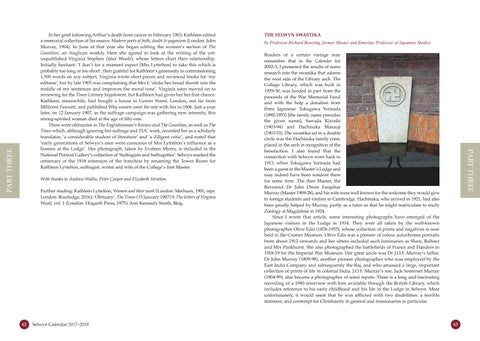ParT THree
With thanks to Andrew Wallis, Peter Cooper and Elizabeth Stratton. Further reading: Kathleen Lyttelton, Women and their work (London: Methuen, 1901, repr. London: routledge, 2016); ‘obituary’, The Times (15 January 1907) 9; The letters of Virginia Woolf, vol. 1 (London: Hogarth Press, 1975); ann Kennedy Smith, Blog.
62
Selwyn Calendar 2017–2018
THE SELWYN SWASTIKA
by Professor Richard Bowring, former Master and Emeritus Professor of Japanese Studies readers of a certain vintage may remember that in the Calendar for 2002-3, I presented the results of some research into the swastika that adorns the west side of the Library arch. The College Library, which was built in 1929-30, was funded in part from the proceeds of the War Memorial Fund and with the help a donation from three Japanese: Tokugawa Yorisada (1892-1955) [the family name precedes the given name], Sawada Kiyoshi (1903-94) and Hachisuka Masauji (1903-53). The swastika set in a double circle was the Hachisuka family crest, placed in the arch in recognition of the benefaction. I also found that the connection with Selwyn went back to 1913, when Tokugawa Yorisada had been a guest in the Master’s Lodge and may indeed have been resident there for some time. The then Master, the reverend Dr John owen Farquhar Murray (Master 1909-28), and his wife were well known for the welcome they would give to foreign students and visitors to Cambridge. Hachisuka, who arrived in 1921, had also been greatly helped by Murray, partly as a tutor so that he might matriculate to study Zoology at Magdalene in 1924. Since I wrote that article, some interesting photographs have emerged of the Japanese visitors in the Lodge in 1914. They were all taken by the well-known photographer olive edis (1876-1955), whose collection of prints and negatives is now held in the Cromer Museum. olive edis was a pioneer of colour autochrome portraits from about 1912 onwards and her sitters included such luminaries as Shaw, Balfour and Mrs Pankhurst. She also photographed the battlefields of France and Flanders in 1918-19 for the Imperial War Museum. Her great uncle was Dr J.o.F. Murray’s father, Dr John Murray (1809-98), another pioneer photographer who was employed by the east India Company and subsequently the raj, and who amassed a large, important collection of prints of life in colonial India. J.o.F. Murray’s son, Jack Somerset Murray (1904-99), also became a photographer of some repute. There is a long and fascinating recording of a 1990 interview with him available through the British Library, which includes reference to his early childhood and his life in the Lodge in Selwyn. Most unfortunately, it would seem that he was afflicted with two disabilities: a terrible stammer, and contempt for Christianity in general and missionaries in particular.
ParT THree
In her grief following arthur’s death from cancer in February 1903, Kathleen edited a memorial collection of his essays: Modern poets of faith, doubt & paganism (London: John Murray, 1904). In June of that year she began editing the women’s section of The Guardian, an anglican weekly. Here she agreed to look at the writing of the yetunpublished Virginia Stephen (later Woolf), whose letters chart their relationship. Initially hesitant: ‘I don’t for a moment expect [Mrs Lyttelton] to take this which is probably too long or too short’, then grateful for Kathleen’s generosity in commissioning 1,500 words on any subject, Virginia wrote short pieces and reviewed books for ‘my editress’, but by late 1905 was complaining that Mrs L ‘sticks her broad thumb into the middle of my sentences and improves the moral tone’. Virginia soon moved on to reviewing for the Times Literary Supplement, but Kathleen had given her her first chance. Kathleen, meanwhile, had bought a house in Gower Street, London, not far from Millicent Fawcett, and published Why women want the vote with her in 1906. Just a year later, on 12 January 1907, as the suffrage campaign was gathering new intensity, this strong-spirited woman died at the age of fifty-one. There were obituaries in The Englishwoman’s Review and The Guardian, as well as The Times which, although ignoring her suffrage and TUC work, recorded her as a scholarly translator, ‘a considerable student of literature’ and ‘a diligent critic’, and noted that ‘early generations of Selwyn’s men were conscious of Mrs Lyttelton’s influence as a hostess at the Lodge’. Her photograph, taken by eveleen Myers, is included in the national Portrait Gallery’s collection of ‘Suffragists and Suffragettes’. Selwyn marked the centenary of the 1918 extension of the franchise by renaming the Tower room for Kathleen Lyttelton, suffragist, writer and wife of the College’s first Master.
63
